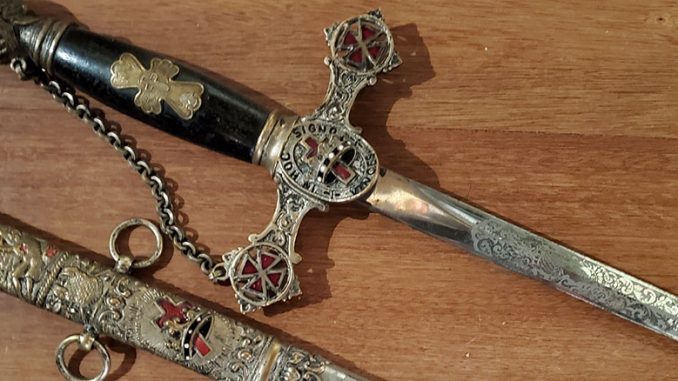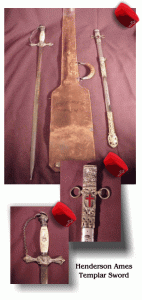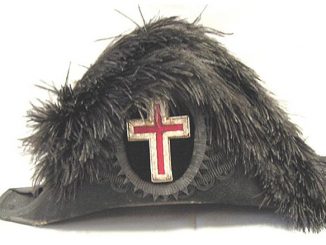
PLEASE NOTE We do not give, nor are we qualified to give, appraisals on your fraternal Masonic Knight Templar swords.
One of the most frequent questions we receive in our email box comes from people trying to learn about Templar swords that they have either purchased at estate sales or inherited from family members who were members of the order.
Many of those asking questions are hoping that they possess a sword from the Middle Ages when the Templars fought in the crusades. They are soon disappointed when they are told that the ornate sword they now possess couldn’t possibly be authentic as the Templar Rule forbade all ornamentation on weapons. Inevitably the sword they are inquiring about is a fraternal Knights Templar sword or “society sword” as they are called among collectors.
The purpose of this page is to explain, not only these fraternal swords but also, the different companies that manufactured them.
 Description Of Masonic Knight Templar Swords
Description Of Masonic Knight Templar Swords
Pommel: Regardless of manufacturer, the pommel almost always depicts a knight’s head. This does not distinguish the sword as uniquely Templar as other fraternal swords such as the Knight’s of Pythias depict a knight’s head as well.
Grip: The grip on a Templar sword is sometimes black and sometimes ivory. Quite often it will depict the cross and crown emblem of the order as shown in the diagram to the left. Some swords will display a stylized Christian cross while others a triangle and cross. Frequently Templar swords are engraved with the owner’s initials on the grip.
Knuckle Guard: Templar sword knuckle guards typically depict the cross and crown but many of the M. C. Liley and Co. swords show a knight’s head as shown in the diagram to the left.
Blade: The blade of the Templar sword is particularly ornate and will often depict crusader scenes and lily work. Virtually every Templar sword made in the last century and a half will carry the engraved name of its owner.
Sheath: A nickel plated sheath indicates the sword belonged to a Sir Knight, while a gold plated one is that of a Preceptor (Canada) or Commander (United States). Like the blade these sheaths are very ornate and the markings will vary from manufacturer to manufacturer.
History Of American Masonic Knight Templar Swords Manufacturers
Frank Henderson, a prominent citizen in Kalamazoo Michigan and whose home, the Henderson – Royce Castle is a prominent site to this day, began selling and manufacturing swords and regalia in 1850. He remained in the business for nearly a half century until his death in 1899. The company he began would remain active until it was dissolved in 1923.
Initially Henderson sold swords under his own name Frank Henderson and would continue to do so until he formed a partnership with Theron F Giddings in 1871. The new company, Henderson and Giddings Co. was a short lived venture and in 1873, Henderson resumed trade as Frank Henderson.
From this time Henderson began an association with the Ames Sword Company and as an agent distributed their line of fraternal swords and regalia. This relationship continued for two decades at which time, in 1893, he consolidated his affairs with Ames and formed the Henderson Ames Company.
Henderson bought out the E. A. Armstrong Regalia Factory, including all machinery and inventories a year later. After Henderson’s death in 1899 the company continued on for the next twenty-four years when it was purchased and dissolved by The M. C. Lilley and Company.
The M. C. Lilley and Company purchased the Ames Sword Company in 1925 and in the same year change their name to The Lilley Company. The newly acquired equipment was moved from Chicopee MA, to Columbus Ohio.
In 1931 they became the Lilley-Ames Company continued on for another two decades but due to a lack of diversity in their product line began to fail. C. E. Ward bought them out in 1951 and at this time began to manufacture badges.
Chronology Of Major American Masonic Knight Templar Swords Manufacturers
With the chronological list below you should be able to get a rough date as to when your sword was made. For example if your sword carries the markings of Henderson Ames, then it was manufactured sometime between 1893 and 1929.
1850 – 1871 – Frank Henderson
Frank Henderson, a notable figure in Kalamazoo, Michigan, established himself as a sword maker from 1850 to 1871. During this period, he gained prominence in the field of sword manufacturing and regalia. Initially selling swords under his own name, Frank Henderson later formed a partnership with Theron F Giddings in 1871 under the name Henderson and Giddings Co. Though their venture was short-lived, Henderson continued his association with the Ames Sword Company, becoming an agent for distributing fraternal swords and regalia. His dedication to the craft and partnership with Ames laid the foundation for a successful legacy in the sword-making industry.
1871 – 1873 – Henderson and Giddings
From 1871 to 1873, Frank Henderson partnered with Theron F Giddings to form the Henderson and Giddings Co. During this brief period, the company engaged in the production and sale of swords and regalia. Although the partnership was short-lived, it contributed to Henderson’s growing reputation in the sword-making business. Despite the eventual dissolution of the company, Henderson’s passion for the craft endured, setting the stage for his subsequent accomplishments in the industry.
1873 – 1893 – Frank Henderson
Following the dissolution of Henderson and Giddings Co., Frank Henderson resumed trade under his own name, Frank Henderson. From 1873 to 1893, he continued his association with the Ames Sword Company, becoming an agent for their line of fraternal swords and regalia. During this period, Henderson’s reputation as a skilled sword maker grew, and his products gained popularity among various fraternal organizations. His commitment to craftsmanship and attention to detail earned him respect in the industry, laying the foundation for the success he would achieve in the years to come.
1893 – 1923 – Henderson Ames
(Henderson Died In 1899)
In 1893, Frank Henderson consolidated his affairs with the Ames Sword Company, forming the Henderson Ames Company. Under this new entity, Henderson continued to manufacture and distribute fraternal swords and regalia. The collaboration with Ames brought together two reputable names in the industry, allowing them to combine their expertise and resources. The Henderson Ames Company flourished during this period, producing high-quality swords adorned with intricate designs and engravings. The swords crafted by Henderson Ames became sought-after items among various fraternal orders and added to the prestige of the company. The successful partnership endured until 1923 when the company was eventually purchased and dissolved by The M. C. Lilley and Company. Despite the eventual change in ownership, the legacy of Henderson Ames as a distinguished sword maker remained a significant chapter in the history of fraternal regalia.
1923 – 1925 – The M. C. Lilley and Company
In 1923, The M. C. Lilley and Company acquired the assets and business of the Henderson Ames Company, marking a significant expansion for the Lilley company. With the acquisition, they obtained not only the existing inventory but also the expertise and reputation of Henderson Ames as a renowned sword maker. As a result, the Lilley company further solidified its position as a prominent manufacturer and distributor of fraternal swords and regalia. The newly acquired equipment and capabilities from Henderson Ames enabled The M. C. Lilley and Company to enhance its product offerings and serve a broader market. The firm continued to uphold the tradition of craftsmanship, producing finely crafted swords and regalia that appealed to various fraternal organizations. In 1925, the company underwent a name change, becoming known as The Lilley Company, which continued to thrive as a premier supplier in the fraternal regalia industry.
1925 – 1931 – The Lilley Company
Following the name change in 1925, The Lilley Company carried on the legacy of its predecessors, continuing to specialize in manufacturing and distributing fraternal regalia, including swords for various fraternal organizations. With the acquisition of the Ames Sword Company’s assets and expertise, The Lilley Company further strengthened its position as a leading supplier in the industry. The move to Columbus, Ohio, allowed the company to expand its operations and better serve its growing customer base. Throughout the years, The Lilley Company maintained a reputation for producing high-quality swords and regalia, and its commitment to craftsmanship and attention to detail made its products highly sought after. However, by the early 1930s, the company faced challenges due to a lack of diversification in its product line, which led to a decline in its financial performance. As a result, significant changes were on the horizon for the once-thriving manufacturer.
1931 – 1951 – Lilley-Ames Company
During the period from 1931 to 1951, the company underwent a significant transformation, adopting the name “Lilley-Ames Company” after the acquisition of the Ames Sword Company’s assets in 1931. The merger aimed to combine the expertise and resources of both companies to create a more robust and diversified organization. With the consolidation of manufacturing capabilities and product lines, Lilley-Ames Company continued its tradition of producing high-quality fraternal regalia, including swords for various fraternal orders. However, the transition also marked a strategic shift as the company began to expand its product offerings to include badges and other fraternal paraphernalia. These new product lines allowed Lilley-Ames Company to reach a broader customer base and adapt to changing market demands. Despite facing challenges during the Great Depression and World War II, the company’s commitment to craftsmanship and customer satisfaction allowed it to remain a respected and prominent name in the fraternal regalia industry throughout this era.
1951 – 1953 – Lilley-Ames Company (Badge Maker New Ownership)
Between 1951 and 1953, the Lilley-Ames Company experienced a change in ownership, leading to a new phase in its history. During this period, the company specialized in badge manufacturing, focusing primarily on producing badges for various organizations and fraternities. With the new ownership, Lilley-Ames continued to build on its reputation for quality craftsmanship and dedication to meeting the needs of its customers. The company’s expertise in badge production allowed it to cater to a wide range of clients, providing them with custom-designed and intricately crafted badges that represented their respective organizations with pride and distinction. Despite the change in ownership, Lilley-Ames maintained its commitment to delivering excellence in its products, ensuring that each badge was a symbol of honor and recognition for the individuals and groups it represented.
In conclusion, the fascination with Templar swords and their historical origins continues to captivate many enthusiasts today. Those who inquire about these swords, hoping to possess a relic from the Middle Ages, often find themselves discovering the reality of fraternal Knights Templar swords or “society swords.” While not authentic artifacts from the crusades, these fraternal swords hold their own significance as symbols of honor and tradition among various fraternal organizations.
The elaborate craftsmanship and design of these swords, particularly the distinct elements such as the knight’s head pommel, cross and crown grip, and ornate blades, reflect the pride and dedication of the craftsmen who created them. As the popularity of fraternal organizations grew, prominent American sword manufacturers like Frank Henderson played a pivotal role in shaping the legacy of sword making. His partnership with Theron F Giddings and later association with the Ames Sword Company further solidified his reputation in the industry, leading to the establishment of the Henderson Ames Company. The subsequent acquisition of Henderson Ames by The M. C. Lilley and Company marked a significant chapter in the evolution of fraternal regalia production.
The Lilley Company’s dedication to craftsmanship and adaptability allowed it to thrive in the market, offering high-quality fraternal regalia, including badges and swords. As the company evolved into the Lilley-Ames Company, it continued to excel in the art of badge manufacturing, representing a new era for the prestigious organization.
Throughout its history, the Lilley-Ames Company left a lasting legacy as a symbol of excellence in the fraternal regalia industry. Whether as a sword manufacturer or a badge maker, its commitment to quality and tradition remained unwavering. The intricate designs and engravings on each fraternal sword and badge were not only decorative symbols but also representations of honor, recognition, and belonging within the various fraternal orders.
As time passed, the Lilley-Ames Company demonstrated that its craftsmanship and dedication to its craft could endure, ensuring that its products would continue to be cherished and valued by collectors and fraternal organizations alike. In this way, the legacy of the Lilley-Ames Company lives on, a testament to the enduring allure of Templar swords and fraternal regalia that transcend time and connect people to a rich and storied history.
About Us
We hope you enjoyed this article on Masonic Knight Templar Swords.
We hope you enjoyed this article on Masonic Knight Templar Swords.
TemplarHistory.com was started in the fall of 1997 by Stephen Dafoe, a Canadian author who has written several books on the Templars and related subjects.
Read more from our Modern Templars Archives – Templar History



